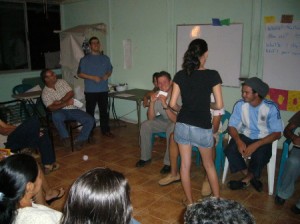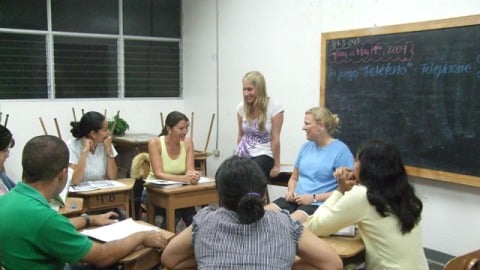Teaching English in Costa Rica – One of the hardest aspects of teaching English as a Second Language is the strategy. When a person trains to be a teacher of non language disciplines, everything from the lesson plan to the presentation to the structure of evaluations is completely different. While subject comprehension is an issue across the board, comprehension between teacher and student rarely is.
 In the ESL world this is the biggest hurdle. While it might be common sense that meaning can be lost in a language classroom, one of the most important – and most often neglected – aspects of a foreign language class is correctly checking student comprehension.
In the ESL world this is the biggest hurdle. While it might be common sense that meaning can be lost in a language classroom, one of the most important – and most often neglected – aspects of a foreign language class is correctly checking student comprehension.
There is a common joke throughout the industry that says that if a student ever nods to signal his or her understanding of a topic, that that actually means the student has no idea what is happening. While meant as a light way to get the message across the new ESL teachers, the joke succinctly summarizes the very thing that makes teaching English so difficult.
Over the last two decades the dominant methodology for teaching English has bent overwhelmingly so to the side of the communicative; most academic circles now agree that the best way to learn a language is by speaking it. And the nodding student falls right in line with this. When asked yes or no questions, students have a fifty percent chance of guessing correctly. If asked if they understand something, a simple nod – most often to avoid embarrassment for not understanding – can confuse a teacher. Nodding along with the answers of other students can also disguise misunderstanding. Tests can, in some cases, be even more troublesome as the teacher doesn’t know how – or how long – they arrived to their answers.
As a result, verbal confirmation of comprehension is key. Asking questions, as well as encouraging questions to be asked among the students themselves, forces the new structure or vocabulary to be used. This is a great way to determine if the days’ lesson has been learned. Similarly, asking identical questions in a different way or questions that require a slightly different response than the one learned will allow a teacher to see if students are simply regurgitating learned responses or have taken the concept to heart and are thus able to apply it to other contexts.
Along this line, it is often stated that the end of an ESL class is actually the most important. The presentation and practice phases of a given lesson are where mistakes are supposed to occur. With a thorough, and strategically angled, follow-up or concluding activity, the teacher can clearly see what the students have grasped and what still needs work.
Given this, what to start the next class with is easier. The teacher then has a starting point to reinforce weak areas. They can also take the areas where the students excelled and use that as a light reinforcement activity to maintain positive self esteem within the class.
Verbal affirmation is one of the best ways to accurately assess student comprehension. Varying questions, changing topics, and changing the person are other ways to check if the concept is learned. With this teachers can feel confident in moving on to their next lesson. Without going through the proper checks teachers run the risk of having students not grasp essential concepts. And without those concepts, learning the next ones is much more difficult.
If you want more information about teaching English in Costa Rica or getting your TEFL or TESOL certificate in Costa Rica feel free to contact Andrew at the Global TESOL College or email andrew@globaltesolcostarica.com
Originally from Toronto, Canada, Woodbury is the academic director of Global TESOL College Costa Rica , a contributor to radio program This Week in Costa Rica (http://thisweekincostarica.com/), and an independent writer based in Costa Rica.

